Mallaig
Mallaig (/ˈmælɪɡ/ (![]()
Mallaig
| |
|---|---|
 Approaching Mallaig harbour on the ferry from the Isle of Skye. | |
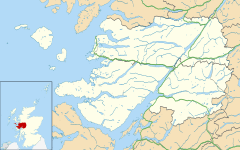 Mallaig Location within the Lochaber area | |
| Population | 797 (2001 Census)[1] |
| OS grid reference | NM 67693 96810 |
| • Edinburgh | 124 mi (200 km) |
| • London | 444 mi (715 km) |
| Council area | |
| Lieutenancy area | |
| Country | Scotland |
| Sovereign state | United Kingdom |
| Post town | MALLAIG |
| Postcode district | PH41 |
| Dialling code | 01687 |
| UK Parliament | |
| Scottish Parliament | |
The village of Mallaig was founded in the 1840s, when Lord Lovat, owner of North Morar Estate, divided up the farm of Mallaigvaig into seventeen parcels of land and encouraged his tenants to move to the western part of the peninsula and turn to fishing as a way of life.[3] The population and local economy expanded rapidly in the 20th century with the arrival of the railway.[3] Ferries operated by Caledonian MacBrayne and Western Isles Cruises sail from the port to Armadale on the Isle of Skye, Inverie in Knoydart, Lochmaddy on South Uist and the isles of Rùm, Eigg, Muck, and Canna. Mallaig is the main commercial fishing port on the West Coast of Scotland, and during the 1960s was the busiest herring port in Europe.[3] Mallaig prided itself at that time on its famous traditionally smoked kippers, the fishmonger Andy Race still providing genuine oak smoked kippers from the factory shop on the harbour. Mallaig and the surrounding area is a popular area for holidays.
The majority of the community speaks English, with a minority of residents speaking both English and Gaelic. In addition, traditional Gaelic is still taught in Mallaig Primary School to pupils who choose to learn the language.
Education
Mallaig has extensive distance learning facilities, allowing the local population access to all forms of education from leisure classes to university degrees through Lochaber College and the UHI Millennium Institute. The College is one of the most successful of its kind in Britain, with over 8% of the local population accessing its facilities. The college has published a PDF version of the 19th century Royal Commission of Inquiry into the Condition of Crofters and Cottars in the Highlands and Islands report.[4] Recently the Learning Centre has opened a marine-specific vocational centre and is at the forefront of developing Marine Certification courses for fishermen, as well as being a RYA certified centre.
Mallaig has its own primary school, which recently accepted the Gaelic medium schoolchildren from Lady Lovat Primary School in the nearby village of Morar, to allow that school to focus more on their English medium students.
Mallaig also has its own High School, opened in 1989 (however a secondary school had previously existed in a slightly different location) which caters for Mallaig, the villages of Morar and Arisaig, along with the nearby Small Isles of Eigg, Rùm, Muck and Canna and finally the nearby Knoydart peninsula. The school has increasing numbers of pupils from the Small Isles, and as daily travel from home to school is impossible, these pupils are boarded in the school's hostel.
Local services
Mallaig has several restaurants, cafes, and takeaways along with a community-run swimming pool and leisure centre. The main focus is on the tourist trade during the summer, however some facilities are open all year round, including the swimming pool. Mallaig has three hotels, much self-catering accommodation and several guest houses.
There are two banks and three pubs. The compact village centre is close to the harbour and railway station, with residential areas beyond to the south and east of the harbour. Most of the retail premises are in the main street, or on Davies Brae, which runs south from the village centre. The swimming pool is at the high point of the village on Fank Brae.
There are two minimarkets, and gift shops. An art gallery sells work by local artists. There is a small bookshop A heritage centre next to the railway station is based around old photographs of the locality, but as Mallaig has only existed during the age of photography this offers a good introduction to the history and heritage of the locality. There are Roman Catholic and Church of Scotland churches, and also a Fishermen's Mission facility run by the Royal National Mission to Deep Sea Fishermen. There is a small petrol station with restricted opening times near the harbour.
Transport

Completed in 1901, the West Highland Line links Mallaig railway station by rail to Fort William, Oban and Glasgow.[5] The line was voted the top rail journey in the world by readers of independent travel magazine Wanderlust in 2009, ahead of the iconic Trans-Siberian and the Cuzco to Machu Picchu line in Peru. The five-hour trip to Glasgow Queen Street railway station passes through spectacular scenery including seascapes, lochsides, mountain and moorland terrain, and offers views of Loch Lomond, the Gare Loch, Rannoch Moor, Ben Nevis, Glenfinnan and Glen Shiel, and Loch Eil. The line also runs along the Clyde between Helensburgh and Glasgow and offers views across the estuary. In the years prior to the First World War, following the opening of the line in 1901 there was a fairly steady increase in the value of fish sold[6], exceeding £60,000 in 1914.
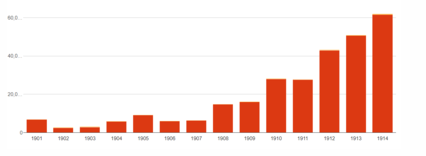
In the summer the Jacobite steam train service from Fort William visits Mallaig.
Shiel Buses operate a bus service from Mallaig to Fort William. Buses also run south along the A861 to the villages of Acharacle and Strontian.
Mallaig is an important ferry port with regular Caledonian MacBrayne ferry services to Armadale on the Isle of Skye, a thirty-minute sailing operated by MV Loch Fyne and MV Lord of the Isles, the latter operating the morning service from Lochmaddy on South Uist to Mallaig, before shuttling between Mallaig and Armadale, then working the evening service back to Lochmaddy. They also run a daily service operated by the MV Lochnevis, purpose built for the route to the Small Isles of Canna, Rùm, Eigg and Muck, although the timetable and itinerary differ from day to day.
In addition, a local ferry service owned by former lifeboatman Bruce Watt sails daily to Inverie in Knoydart, a very remote village, and also calls by prior arrangement at Tarbet in Morar, a location that is only accessible by sea. This service also offers a non-landing cruise through scenic Loch Nevis.

Mallaig as a filming location
The Mallaig railway was used during the filming of the Harry Potter series of films, and the Hogwarts Express could often be seen in the summer during periods of filming. Many other local areas were used for location filming.
The 1996 film Breaking the Waves was largely filmed in Mallaig and the surrounding area, and the beach scenes of Local Hero were filmed at Morar and Arisaig, a few miles to the south.
Mallaig also features in the book 'Blood Beneath Ben Nevis' by Mark Bridgeman, published by Watermill Press in 2020.
Gallery
 Approaching Mallaig harbour on the ferry from Skye
Approaching Mallaig harbour on the ferry from Skye Mallaig harbour from the ferry to the Isle of Skye
Mallaig harbour from the ferry to the Isle of Skye.jpg) Mallaig viewed from the Ferry Road to the north of the village
Mallaig viewed from the Ferry Road to the north of the village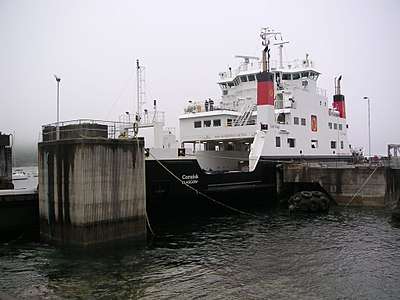 The Mallaig to Armadale car ferry
The Mallaig to Armadale car ferry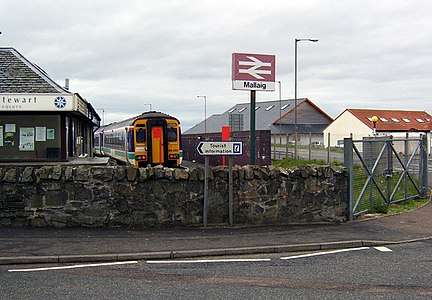 Mallaig railway station
Mallaig railway station Mallaig harbour
Mallaig harbour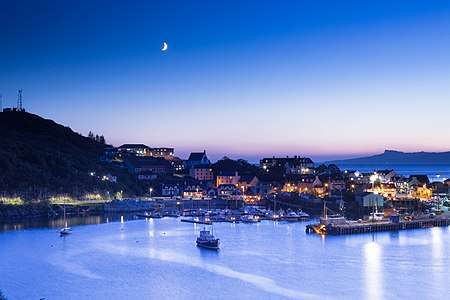 Mallaig from the hill above East Bay under an autumn moon
Mallaig from the hill above East Bay under an autumn moon
References
- "Comparative Population Profile: Mallaig Locality, Scotland". Scotland's Census Results OnLine. Archived from the original on 22 March 2012. Retrieved 7 March 2011.
- "Mallaig circuit". walkhighlands. walkhighlands. Retrieved 9 March 2011.
- Anon. "Mallaig and its story". Mallaig Heritage Centre. Archived from the original on 4 March 2004. Retrieved 14 September 2009.
- Anon (2007). "The Royal Commission of Inquiry into the Condition of Crofters and Cottars in the Highlands and Islands". Lochaber College e-library. Lochaber College. Retrieved 14 September 2009.
- "Glasgow to Mallaig: Great Train Journeys". Daily Telegraph. 4 March 2013.
- "Scottish Herring History: Creek Statistics". Retrieved 3 July 2018.
External links
- Map sources for Mallaig
- Photos of Mallaig
- West Word - Community Newspaper
- Breaking the Waves filming locations
- Local Hero filming locations
- West Highland Railway Mallaig Extension
- Mallaig High School
- Mallaig Pool & Leisure
| Wikimedia Commons has media related to Mallaig. |